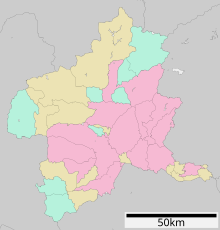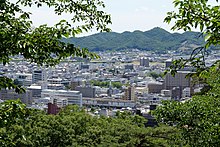Gunma Prefecture
Gunma Prefecture
Đàn mã huyện | |
|---|---|
| Japanese transcription(s) | |
| •Japanese | Đàn mã huyện |
| •Rōmaji | Gunma-ken |
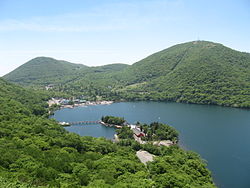 Ono Lake, Jizō-dake | |
| Anthem:Gunma-ken no uta | |
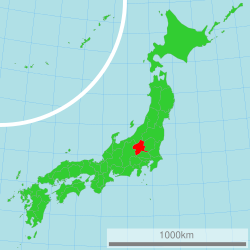 | |
| Coordinates:36°23′N139°04′E/ 36.39°N 139.06°E | |
| Country | |
| Region | Kantō |
| Island | Honshu |
| Capital | Maebashi |
| Largest city | Takasaki |
| Subdivisions | Districts:7,Municipalities:35 |
| Government | |
| •Governor | Ichita Yamamoto |
| Area | |
| • Total | 6,362.28 km2(2,456.49 sq mi) |
| • Rank | 21st |
| Population (October 1, 2019) | |
| • Total | 1,937,626 |
| • Rank | 18th |
| • Density | 300/km2(790/sq mi) |
| • Dialect | Gunma dialect |
| GDP | |
| • Total | JP¥9,308 billion US$85.4 billion (2019) |
| ISO 3166 code | JP-10 |
| Website | www |
| Symbols of Japan | |
| Bird | Copper pheasant (Phasianus soemmerringii) |
| Fish | Sweetfish(Plecoglossus altivelis) |
| Flower | Japanese azalea (Rhododendron japonicum) |
| Tree | Japanese black pine (Pinus thunbergii) |
Gunma Prefecture(Đàn mã huyện,Gunma-ken)is a landlockedprefectureofJapanlocated in theKantō regionofHonshu.[2]Gunma Prefecture has a population of 1,937,626 (1 October 2019) and has a geographic area of 6,362km2(2,456sq mi). Gunma Prefecture bordersNiigata PrefectureandFukushima Prefectureto the north,Nagano Prefectureto the southwest,Saitama Prefectureto the south, andTochigi Prefectureto the east.
Maebashiis the capital andTakasakiis the largest city of Gunma Prefecture, with other major cities includingŌta,Isesaki,andKiryū.[3]Gunma Prefecture is one of only eightlandlockedprefectures, located on the northwestern corner of theKantō Plainwith 14% of its total land being designated asnatural parks.
History[edit]
The ancient province of Gunma was a center of horse breeding and trading activities for the newly immigrated continental peoples (orToraijin). The arrival of horses and the remains of horse tackle coincides with the arrival of a large migration from the mainland. From this point forward, the horse became a vital part of Japanese military maneuvers, quickly displacing the older Yayoi tradition of fighting on foot.[citation needed]
WhenMount Harunaerupted in the late 6th century, Japan was still in the pre-historical phase (prior to the importation of the Chinese writing system during the Nara period). The Gunma Prefectural archaeology unit in 1994 was able to date the eruption through zoological anthropology at the corral sites that were buried in ash.[citation needed]
In the past, Gunma was joined withTochigi Prefectureand calledKenu Province.This was later divided intoKami-tsu-ke(Upper Kenu, Gunma) andShimo-tsu-ke(Lower Kenu, Tochigi). The area is sometimes referred to as Jomo ( thượng mao,Jōmō). For most of Japanese history, Gunma was known as the province ofKozuke.[4]
In the early period of contact between western nations and Japan, particularly the late Tokugawa, it was referred to by foreigners as the "Joushu States", inside (fudai, or loyalist) Tokugawa retainers and the Tokugawa family symbol is widely seen on public buildings, temples, and shrines.[citation needed]
TheTenmei eruptionofMount Asamaoccurred in 1783, causing enormous damage.[5][6]
The first modern silk factories were built with Italian and French assistance at Annaka in the 1870s.
In the early Meiji period, in what was locally called the Gunma Incident of 1884, a bloody struggle between the idealistic democratic westernizers and the conservative Prussian-model nationalists took place in Gunma and neighboring Nagano. The modern Japanese army gunned down farmers with new repeating rifles built in Japan. The farmers in Gunma were said to be the first victims of theMurata rifle.[citation needed]
In the twentieth century, the Japanese aviation pioneer Nakajima Chikushi of Oizumi, Gunma Prefecture, founded theNakajima Aircraft Company.At first, he produced mostly licensed models of foreign designs, but beginning with the all-JapaneseNakajima 91fighter plane in 1931, his company became a world leader in aeronautical design and manufacture, with its headquarters at Ota, Gunma Ken. The factory now producesSubarumotorcars and other products under the name ofSubarunée Fuji Heavy Industries.[7]
In the 1930s, German architectBruno Julius Florian Tautlived and conducted research for a while in Takasaki.[8]
TheGirard incident,which disturbed US-Japanese relations in the 1950s, occurred in Gunma in 1957, atSōmagahara BasenearShibukawa.
Four modern prime ministers are from Gunma, namely,Takeo Fukuda,Yasuhiro Nakasone,Keizo Obuchi,andYasuo Fukuda,the son of Takeo.
Geography[edit]
One of only eight landlocked prefectures in Japan, Gunma is the northwesternmost prefecture of the Kantō plain. Except for the central and southeast areas, where most of the population is concentrated, it is mostly mountainous. To the north areNiigataandFukushimaprefectures, while to the east liesTochigi Prefecture.To the west lies theNagano Prefecture,and theSaitama Prefectureis to the south.
Some of the major mountains in Gunma areMount Akagi,Mount Haruna,Mount Myōgi,Mount Nikkō-ShiraneandMount Asama,which is located on the Nagano border. Major rivers include theTone River,theAgatsuma River,and theKarasu River.
As of 1 April 2012, 14% of the total land area of the prefecture was designated asNatural Parks,namelyJōshin'etsu-kōgen,Nikkō,andOzeNational Parks andMyōgi-Arafune-Saku Kōgen Quasi-National Park.[9]
Cities[edit]
Twelve cities are located in Gunma Prefecture:
Towns and villages[edit]
These are the towns and villages in eachdistrict:
Mergers[edit]
Climate[edit]

Because Gunma is situated in inland Japan, the difference in temperature in the summer compared to the winter is large, and there is less precipitation. This is because of thekarakkaze( "empty wind" ), a strong, dry wind that occurs in the winter when the snow falls on the coasts of Niigata. The wind carrying clouds with snow are obstructed by theEchigo Mountains,and it also snows there, although the high peaks do not let the wind go past them. For this reason, the wind changes into thekara-kaze.
- Climate inMaebashi
- Average yearly precipitation: 1,163 mm (approx. 45.8in)
- Average yearly temperature: 14.2 degrees Celsius (approx. 57.6 degrees Fahrenheit)
Economy[edit]
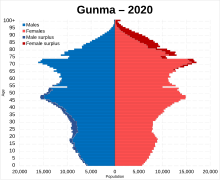
Gunma's modern industries include transport equipment and electrical equipment, concentrated aroundMaebashiand the eastern region nearestTokyo.More traditional industries includesericultureandagriculture.Gunma's major agricultural products includecabbagesandkonnyaku.Gunma produces over 90% of Japan's konnyaku, and two-thirds of the farms in the village ofTsumagoiare cabbage farms.[10]Also, the city ofŌtais famous for the car industry, notably theSubarufactory.
Culture[edit]
There is alocal dialect,known in Japanese as 'gunma-ben' or 'jōshū-ben'.
Gunma has a traditional card game calledJomo Karuta(Thượng mao かるた).It features people, places, and things of regional and/or cultural importance.
Famous foods[edit]
In 2007, the Ministry of Agriculture, Forestry and Fisheries held an event to find the top 100 best local dishes across all of Japan. Three dishes were featured from Gunma; yaki-manju,okkirikomi,andkonnyaku.[11]
Melody Roads[edit]
As of 2018, Gunma is home to eleven of Japan's over thirtyMelody Roads.2,559 grooves cut into a 175-meter stretch of the road surface in transmit atactilevibrationthrough the wheels into thecar body.[12][13][14]The roads can be found in Katashina, Minakami, Takayama, Kanna, Ueno, Kusatsu, Tsumagoi, Nakanojo, Takasaki, Midori, and Maebashi. Each is of a differing length and plays a different song. Naganohara also used to be home to a Melody Road playing "Aj, lučka lučka siroka", though the road in question was paved over in 2013 due to noise complaints.
Songs[edit]
- Kusatsu - "Kusatsu-Bushi"
- Takayama - "When You Wish Upon a Star"
- Tsumagoi - "Oh My Darling Clementine"
- Nakanojo - "Always With Me" (Japanese title: いつも gì độ でも,itsumo nando demo) fromSpirited Awaywhen driven at 40 km/h
- Katashina - "Memories of Summer"when driven over at 50 km/h
List of governors of Gunma Prefecture (1947–present)[edit]
| Governor | Term start | Term end |
|---|---|---|
| Shigeo Kitano( bắc dã trọng hùng ) | 12 April 1947 | 25 June 1948 |
| Yoshio Iyoku ( y có thể phương hùng ) | 10 August 1948 | 4 July 1952 |
| Shigeo Kitano | 2 August 1952 | 1 August 1956 |
| Toshizo Takekoshi ( trúc eo tuấn tàng ) | 2 August 1956 | 1 August 1960 |
| Konroku Kanda ( thần điền khôn sáu ) | 2 August 1960 | 1 August 1976 |
| Ichiro Shimizu ( nước trong một lang ) | 2 August 1976 | 12 June 1991 |
| Hiroyuki Kodera ( tiểu chùa hoằng chi ) | 28 July 1991 | 27 July 2007 |
| Masaaki Osawa( đại trạch chính minh ) | 28 July 2007 | 27 July 2019 |
| Ichita Yamamoto( sơn bổn một quá ) | 28 July 2019 | present |
Education[edit]
Universities[edit]
- Isesaki
- Jobu University– Isesaki Campus
- Tokyo University of Social Welfare– Isesaki Campus
- Maebashi
- Midori
- Ota
- Takasaki
- Takasaki City University of Economics
- Takasaki University of Commerce
- Takasaki University of Health and Welfare
- Gunma Paz College
- Jobu University -Takasaki Campus
- Tamamura
Sports[edit]

The sports teams listed below are based in Gunma.
Baseball[edit]
Football (soccer)[edit]
Rugby[edit]
Basketball[edit]
Gunma is also famous for its ski resorts in the mountains.
Gunma was the only prefecture in Japan to have all 4 legal types of gambling on races:horse,bicycle,autoandboat.This changed with the closing of the last horse race track in Takasaki in 2004.
Tourism[edit]
Gunma has manyhot spring resortsand the most famous isKusatsu Onsen.Another draw to the mountainous Gunma is theskiresorts.
Other attractions include:
- Lake Nozori
- Hara Museum Arc
- Ikaho Sistina Trick Art Museum
- Mount Haruna
- Kusatsu Alpine-Plant Museum
- Kusatsu Hot-Spring Museum
- Mount Kusatsu-Shirane
- Mount Tanigawa
- Mount Akagi
- Mount Myōgi
- Fukiware Falls
- The Museum of Modern Art, Gunma
- Konnyaku Park
- Shorinzan Daruma Temple
-
Kiryū Yagi-bushi Festival, where held on early August on every year.
-
A Tomioka Silk Mill, a World Heritage cultural property site.
-
A many daruma doll set at Shorinzan Daruma Temple in Takasaki
-
Kenashi Pass on the border of Nagano Prefecture is famous on the internet
Transportation[edit]
Rail[edit]
- JR East
- Joetsu Shinkansen
- Hokuriku Shinkansen
- Takasaki Line
- Shinetsu Line(Takasaki-Yokokawa)
- Joetsu Line
- Agatsuma Line
- Ryomo Line
- Hachiko Line(Kuragano-Hachioji)
- Tobu Railway
- Joshin Electric Railway(Takasaki-Shimonita)
- Jomo Electric Railway(Chuo Maebashi-Nishi Kiryu)
- Watarase Keikoku Railway Watarase Keikoku Line
Roads[edit]
Expressways[edit]
- Kan-Etsu Expressway
- Tōhoku Expressway
- Jōshin-etsu Expressway
- Kita-Kantō Expressway(Takasaki-Hitachinaka)
National highways[edit]
- National Route 17(Nihonbashiof Tokyo-Saitama-Kumagaya-Takasaki-Shibukawa-Ojiya-Nagaoka)
- National Route 18(Takasaki-Annaka-Karuizawa-Komoro-Nagano-Myoko-Joetsu)
- National Route 50(Maebashi-Isesaki-Oyama-Yuki-Mito)
- National Route 120
- National Route 122
- National Route 144
- National Route 145
- National Route 146
- National Route 254
- National Route 291
- National Route 292
- National Route 299
- National Route 353
- National Route 354
- National Route 405
- National Route 406
- National Route 407
- National Route 462
Prefectural symbols[edit]
The prefectural symbol consists of the firstkanjiof the word 'Gunma' surrounded by three stylized mountains symbolizing the three important mountains of Gunma Prefecture:Mount Haruna,Mount Akagi,andMount Myōgi.
For marketing, the Prefectural Government also usesGunma-chan,a smallsuper deformeddrawing of a horse character wearing a green cap. It is used on promotional posters, banners, and other notable printed materials from the Prefectural Government. Other agencies and companies formally or informally use variations of its likeness and other horse-shaped characters when making signs or notices for work on buildings, roads, and other public notices.
In popular culture[edit]
There are various manga and anime that have based their settings in Gunma, such as:
InZom 100: Bucket List of the Dead,the main character Akira Tendo is from Gunma Prefecture.
See also[edit]
Notes[edit]
- ^"2020 niên độ quốc dân kinh tế tính toán ( 2015 năm tiêu chuẩn cơ bản ・2008SNA ): Kinh tế xã hội tổng hợp viện nghiên cứu - Nội Các phủ".Nội Các phủ ホームページ(in Japanese).Retrieved2023-05-18.
- ^Nussbaum, Louis-Frédéric. (2005). "Gumma-ken" inJapan Encyclopedia,p. 267,p. 267, atGoogle Books;"Kantō" inp. 479,p. 479, atGoogle Books.
- ^Nussbaum, "Maebashi" inp. 600,p. 600, atGoogle Books.
- ^Nussbaum, "Provinces and prefectures" inp. 470,p. 470, atGoogle Books.
- ^"Bình minh 3 năm ( 1783 năm ) thiển gian sơn phun hỏa".ktr.mlit.go.jp(in Japanese).Archivedfrom the original on 2022-01-20.Retrieved2022-04-16.
- ^"Bình minh thiển gian sơn phun hỏa とは".Kotobank(in Japanese).Archivedfrom the original on 2021-12-14.Retrieved2022-04-16.
- ^"FUJI HEAVY INDUSTRIES LTD. CHANGES COMPANY NAME TO SUBARU CORPORATION".March 31, 2017.Archivedfrom the original on April 15, 2023.RetrievedApril 15,2023.
- ^"Bruno Taut".Architectuul.Archivedfrom the original on 2023-03-18.Retrieved2023-03-18.
- ^"General overview of area figures for Natural Parks by prefecture"(PDF).Ministry of the Environment.1 April 2012.Archived(PDF)from the original on 21 April 2012.Retrieved3 December2013.
- ^"こんにゃくをめぐる sự tình"(PDF).Nông lâm nghiệp thủy sản tỉnh の công thức HP.Ministry of Agriculture, Forestry and Fisheries. Archived fromthe original(PDF)on 27 December 2021.Retrieved8 June2022.
- ^"JAPAN'S TASTY SECRETS".Nông lâm nghiệp thủy sản tỉnh の công thức HP.The Ministry of Agriculture, Forestry and Fisheries.Archivedfrom the original on 8 June 2022.Retrieved8 June2022.
- ^Johnson, Bobbie (13 November 2007)."Japan's melody roads play music as you drive".The Guardian.Farringdon Road,London,England:GMG.p. 19 (International section).Archivedfrom the original on 1 September 2013.Retrieved20 October2008.
- ^"Your car as a musical instrument – Melody Roads".Noise Addicts. 29 September 2008.Archivedfrom the original on 13 September 2018.Retrieved20 October2008.
- ^Archived atGhostarchiveand theWayback Machine:"Singing Roads – Take a Musical Trip in Japan".ITN.5 December 2007.Retrieved20 October2008.
References[edit]
- Nussbaum, Louis-Frédéric and Käthe Roth. (2005).Japan encyclopedia.Cambridge:Harvard University Press.ISBN978-0-674-01753-5;OCLC 58053128
- "Gunma Prefecture: Location and Topography".Gunma Prefecture HomePage.October 2006. Archived fromthe originalon 2006-10-16.Retrieved2006-10-19.
External links[edit]
- Gunma Prefecture Official Website(in Japanese)
- Gunma Prefecture Official Website(in English)



